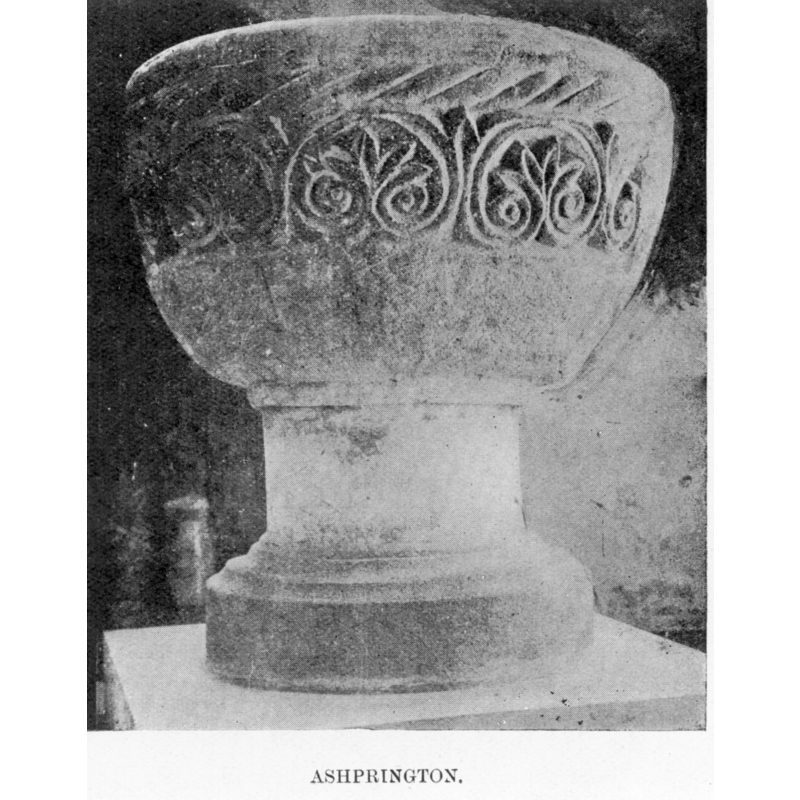Ashprington

Image copyright © [in the public domain]
PD
Results: 5 records
B01: design element - motifs - foliage - honeysuckle or palmetto
BBU01: design element - motifs - rope moulding
LB01: design element - motifs - roll moulding - 2
R01: design element - motifs - roll moulding
INFORMATION
FontID: 06603ASH
Object Type: Baptismal Font1
Church/Chapel: Parish Church of St. David
Church Patron Saints: St. David [aka David of Wales, Davidus, Dewy]
Country Name: England
Location: Devon, South West
Directions to Site: Located 4-5 km S of Totnes, about 15 km SW of Torquay
Font Location in Church: Inside the church
Century and Period: 12th century, Norman
Cognate Fonts: Fonts of this type at: Ashprington, Blackauton, Buckfastleigh, Denbury, Cornworthy, Dartmouth St. Petrock's, Paignton St Andrew's, Plymstock, South Brent, Thurlestone, Ugborough and Wolbororugh, all in Devon
Font Notes:
Click to view
Described in Worthy (1887): "The font, of red sandstone, is circular and of Norman date, and is ornamented with the cable moulding and rudely executed foliage. I believe It to be in its original position; but the door which anciently existed near it has been closed up." Listed in Cox & Harvey (1907) as a baptismal font of the Norman period. Described and illustrated in Clarke (1916) as one of twelve Devon fonts of about the same period [Norman/Late Norman] decorated with a prominent band of honeysuckle or palmetto motif all around the basin [the twelve are: Ashprington, Blackauton, Buckfastleigh, Denbury, Cornworthy, Dartmouth St. Petrock's, Paignton St Andrew's, Plymstock, South Brent, Thurlestone, Ugborough and Wolbororugh, all in Devon]. "This font", adds Clarke (ibid.), "resembles Blackauton in shape and style, but the honeysuckle band is rather narrower, and below it, instead of a saw-tooth there is a plain surface, 10 inches deep. This is the first sign of the tendency to reduce, and eventually discard ornament, which culminated in the thirteenth century in very plain fonts. Ashprington font is entirely of red sandstone, and is in excellent condition, not cracked at all. There is a round moulding between bowl and shaft, and a circular base 1 1/4 inches deep which looks original; there is a round slab beneath it which is an addition, and it is further raised on two modern steps. The bowl has a lead lining." Noted in Pevsner (1952): Font. Circular, Norman, with palmette frieze and a strip of cable moulding above."
MEDIUM AND MEASUREMENTS
Material: stone, sandstone (red)
Font Shape: hemispheric (mounted)
Basin Interior Shape: round
Basin Exterior Shape: round
Drainage Notes: lead lining
Rim Thickness: 7 cm [calculated]
Diameter (inside rim): 62.5 cm*
Diameter (includes rim): 86.25 cm*
Basin Depth: 30 cm*
Basin Total Height: 48.75 - 58.75 cm*
Height of Central Column: 20 cm*
Font Height (less Plinth): 96.25 cm*
Notes on Measurements: * [measurements given in inches in Clarke (1916: 319)]
REFERENCES
Clarke, Kate M., "The baptismal fonts of Devon -- Part IV", 48, Report and Transactions of the Devonshire Association for the Advancement of Science, Literature and Art, 1916, pp. 302-319; p. 316, 319 and pl. IX (opp. p. 316)
Cox, John Charles, English Church Furniture, New York: E.P. Dutton & Co., 1907
Pevsner, Nikolaus, South Devon, Harmondsworth: Penguin Books, 1952
Worthy, Charles, Devonshire parishes, or the antiquities, heraldry and family history of twenty-eight parishes in the Archdeaconry of Totnes, Exeter; London: William Pollard; George Redway, 1887